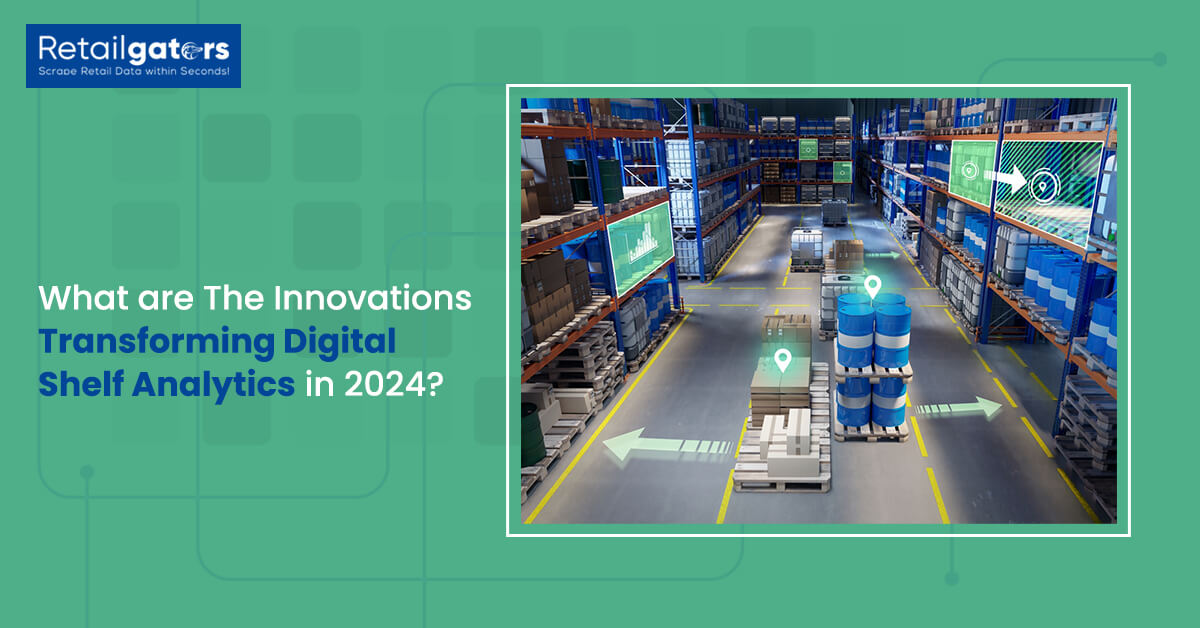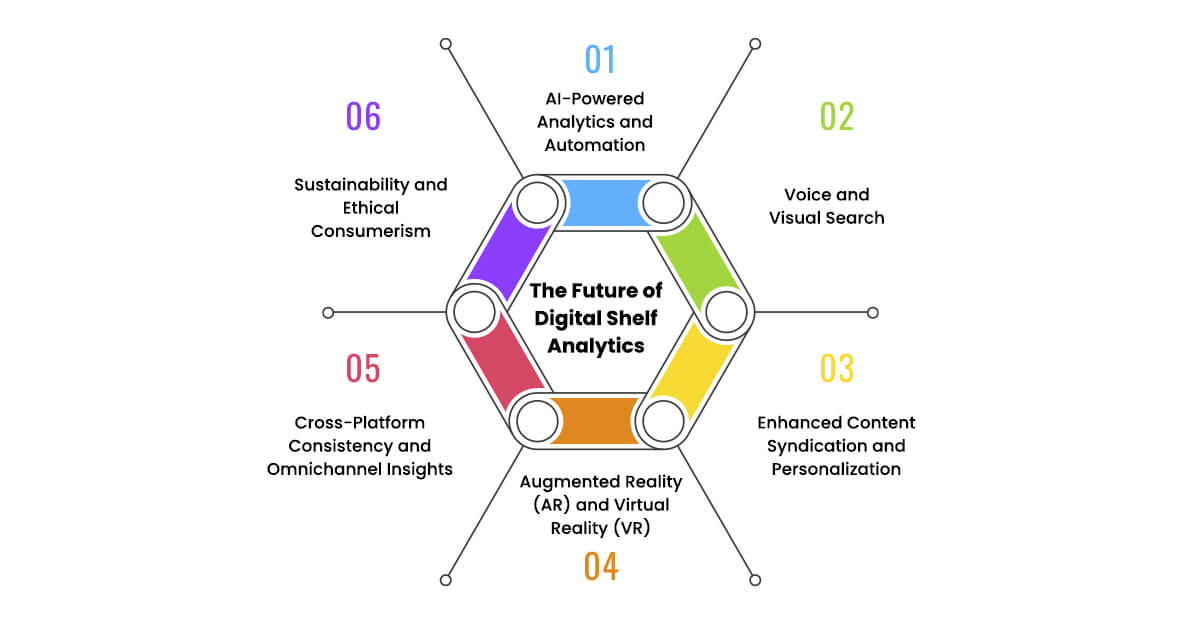
The significant upsurge of online product selling, or eCommerce, over the last decade has changed customers' shopping habits, business services, product types, and decision-making processes. The centre point of this transformation is the digital shelf—a virtual space that helps customers discover, evaluate, and purchase products online. In the highly competitive e-commerce business industry, brands require accurate and real-time data to evolve how products are performing across online selling platforms. Data collected from digital shelf analytics helps adopt data-driven strategies to understand and optimize overall product performance over digital platforms. As the online product-selling business grows, digital shelf analytics also greatly changes. The effects of advanced technologies and business strategies continue to innovate how DSA performs.
In this blog, we will explore the future of digital shelf analytics, focusing on emerging trends and innovations to watch, along with best practices to follow that will shape how businesses navigate the increasingly complex digital landscape.
What is Digital Shelf Analytics?
Before embarking on the journey to reveal digital shelf analytics' future trends and innovations, let’s familiarize ourselves with digital shelf and digital shelf analytics.
A digital shelf is a virtual shelf representing various products on e-commerce websites, retailer sites, social media, and mobile apps. It displays product details such as descriptions, pricing, images, customer reviews, and availability.
Analyzing digital shelf data can be done with Digital shelf analytics, it is a tool or technology which is useful to track, analyze, and optimize the performance of products across virtual shelves. With the help of digital shelf analytics, brands can monitor product positions, identify gaps in the content, know what customers think, track and optimize prices, and keep an eye on competitors.
The Future of Digital Shelf Analytics: Key Trends and Innovations

Digital shelf analytics helps to analyze collected data to make data-driven decisions to improve product visibility, increase sales, and enhance overall customer satisfaction.
AI-Powered Analytics and Automation
Advanced technologies such as artificial intelligence, machine learning, and natural language processing rapidly reshape digital shelf analytics with advanced features. These technologies help quickly process vast data and deliver accurate and deep insights to businesses related to consumer purchase behavior, market trends, and competitor activities.
It is predicted that artificial intelligence and machine learning will replace manual tasks with automation. This will help manage digital shelves precisely to achieve profitable business results. Optimizing content, altering product prices, and tracking stock can be handled perfectly. AI will assist in optimizing product listings with keyword analysis, image analysis, price optimization, and more to stay ahead of the competition and follow the trends.
Along with AI and ML, predictive analytics will become a key player in forecasting future product performance and consumer needs. This level of automation will allow e-commerce managers to focus on strategy rather than tactical adjustments, significantly increasing operational efficiency. Voice Commerce and Visual Search Optimization.
Voice and Visual Search
Amazon Alexa and Google Assistant, tools that work with voice commands, are highly used by consumers to shop online. Utilization of these technologies is also helping the voice search method become more popular daily. In the future, digital shelf analytics will also implement these technological marvels.
Brands must ensure that their product descriptions and content are optimized for voice search algorithms, which often interpret queries differently than traditional text searches.
Consumers are now adopting image-based searches, especially for fashion and home decor products. Visual search is becoming popular as it helps buyers see how the real product will look. Digital shelf analytics platforms must track how well products perform in visual search results and offer tools to optimize product images and metadata to increase discoverability through this channel.
Enhanced Content Syndication and Personalization
Nowadays, product personalization is essential for eCommerce platforms. DAS (Digital Shelf Analytics) helps to arrange the digital shelf with better product personalization and improve the consumer shopping experience.
Businesses can offer better products, descriptive content, offers, and more by analyzing customers' purchase patterns. This allows businesses to serve consumers according to their demands, increase digital footprints, and build a strong consumer base.
Along with personalization, content syndication is also an important trend to follow. It is the process of ensuring consistency in product details across multiple platforms.
Data insights will help brands customize product details, images, and offers for specific groups or individual consumers. Implementing customization will ensure that every product is displayed in a way that matches the varied audiences and manages brand image.
Augmented Reality (AR) and Virtual Reality (VR) Integration
As augmented reality and virtual reality become popular, these advanced technologies will be crucial in transforming the digital shelf. Nowadays, online retailers provide AR facilities for users to "try on" products digitally and see how products will look in different places. In the future, digital shelf analytic tools will trace how AR and VR-driven engagement impacts sales and conversions. E.g. if online buyers utilize AR functionality to see the product by various angles, digital shelf analytics could track all the interactions and deliver data insights related to how much AR experience affects the purchase of the product.
By integrating AR/VR data, brands will better understand how immersive technologies impact the customer journey.
Cross-Platform Consistency and Omnichannel Insights
Nowadays, eCommerce is becoming more omnichannel. It helps to manage product representation across various platforms and increases consumer satisfaction across all platforms, devices, and touchpoints. Future digital shelf analytics tools will offer brands a unified view of their product performance across e-commerce websites, social media platforms, and brick-and-mortar stores.
Omnichannel analytics, equipped with advanced technologies, help businesses follow consumer journeys that route through various touchpoints and devices. They also provide data insights on how various channels contributed to sales and customer engagement. Cross-platform consistency will help build more effective marketing strategies and deliver better customer experiences.
Sustainability and Ethical Consumerism
In today’s world of online shopping, customers are looking for genuine and reliable products. Digital shelf analytics assist brands in tracking their efforts related to maintaining product sustainability. Analytics platforms will offer insights into how products labeled as "eco-friendly," "fair trade," or "carbon-neutral" perform compared to competitors.
This way, brands can discover opportunities to improve their product sustainability. Digital shelf analytics tools will progressively unite metrics related to product lifecycle, supply chain transparency, and environmental impact. By providing real-time insights into how sustainability initiatives resonate with consumers, brands can refine their strategies to align with ethical consumerism trends.
Future Challenges in Digital Shelf Analytics
With the rise and adoption of advanced technologies and the following trends, the future of digital shelf analytics is very bright. However, several challenges also need to be overcome to gain maximum profit and stay competitive in the marketplace.
Data Privacy and Compliance
As data protection rules like GDPR and CCPA are introduced, brands must be more careful when using consumer data. Data privacy rules force businesses to follow strict guidelines for data usage. Brands must comply with data use and adopt a new approach for better data management.
Data Overload
With so much data available, distinguishing between actionable insights and noise will be a challenge. Future platforms must focus on refining data collection processes and offering more intuitive ways to interpret vast amounts of information.
Integration with Legacy Systems
Many companies still rely on legacy systems not built for the modern digital shelf. Seamless integration of digital shelf analytics with existing ERP, CRM, and PIM systems will ensure a smooth transition into the future.
Real-time monitoring and adaptability
Frequent updates are necessary for real-time analytics, but as data volumes increase, so do server expenses and processing delays. For certain analytics, edge computing or on-device processing may allow quicker reaction times without raising server expenses.
Localization for Global Marketplaces
Localizing language, pictures, and messaging in different worldwide markets can be challenging. However, marketers can tailor their strategy based on country specifications by using AI-driven translation tools and market-specific analytics without human intervention.
Virtual and Augmented Reality (AR/VR)
The increased use of AR and VR in online buying makes it difficult to analyze efficacy and engagement in these settings. Extensive reality (XR) analytics can direct future research and development in immersive retail by evaluating user interaction in AR/VR environments.
Predicting stock availability and demand fluctuations.
Accurate demand forecasting is necessary to maintain proper product availability while reducing overstock, and global supply chain problems can interfere. Demand forecasts may be enhanced by AI-driven predictive analytics that uses outside data (weather, market trends).
Conclusion
As we understand that the future of digital shelf analytics is very bright with implementation of advanced tools and technologies and marked by innovation, automation, and more personalization. Businesses need to leave traditional methods and turn towards AI-powered analytics, emerging technologies such as voice and visual search, AR/VR, and more. Adopting new technologies will help to build effective omnichannel strategies to stay competitive in the digital landscape.
Consumer expectation standards are increasing daily, and businesses need to fulfill those expectations. Future-ready technologies power digital shelf analytics, assist in gaining a competitive edge, and attract more consumers. The journey toward a smarter, more data-driven approach to managing the digital shelf is just beginning, and it can become easy with RetailGators, which leverage diverse opportunities.








Leave a Reply
Your email address will not be published. Required fields are marked